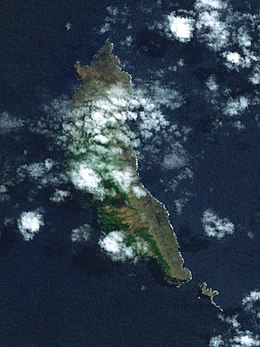Mohotani
This article needs additional citations for verification. (June 2014) |
 Moho Tani viewed from space | |
 Location of Mohotani within the Marquesas Islands | |
| Geography | |
|---|---|
| Location | South Pacific Ocean |
| Coordinates | 9°59′02″S 138°49′47″W / 9.9838°S 138.8296°WCoordinates: 9°59′02″S 138°49′47″W / 9.9838°S 138.8296°W |
| Archipelago | Marquesas Islands |
| Area | 15 km2 (5.8 sq mi) |
| Administration | |
| Overseas country | French Polynesia |
Mohotani (sometimes spelt Moho Tani; also called Molopu or Motane) is an uninhabited island southeast of Hiva Oa and east of Tahuata in the southern Marquesas Islands. It has an area of 15 km2. Much of the island's sparse vegetation has been destroyed by feral goats and sheep, to the extent that following its rare rains, the sea around it is stained red from runoff. Early reports describes the island as fertile, with forest and fields. When Thor Heyerdahl visited the island in 1938, there were only a few goats and remains of deserted huts and villages.
Mohotani is administratively part of the commune (municipality) of Hiva-Oa, itself in the administrative subdivision of the Marquesas Islands.
It is reported that at one time the island was inhabited by a clan called the “Moi a Tiu”, but that population has long since been wiped out by disease and war, the few survivors having departed for Hiva ʻOa. In pre-European times, the island was considered part of the territory of the province of .
In 1992, the island and its surrounding smaller islands (including Terihi) were officially protected by the declaration of the Motane Nature Reserve.
History[]
European exploration[]
The first recorded sighting of Mohotani by the Europeans was by the Spanish expedition of Álvaro de Mendaña on 21 July 1595. They charted it as San Pedro.[1]
See also[]
- Terihi
- Desert island
- List of islands
References[]
- ^ Sharp, Andrew The discovery of the Pacific Islands Clarendon Press, Oxford, 1960, p.51.
Resources[]
- Christian, F.W. Eastern Pacific Lands, Tahiti and the Marquesas Islands. London, 1910.
- Heyerdahl, Thor: Fatuhiva
- Islands of the Marquesas Islands
- Uninhabited islands of French Polynesia
- Former populated places in Oceania
- French Polynesia geography stubs
